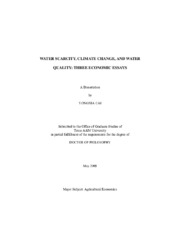| dc.contributor.advisor | McCarl, Bruce A. | |
| dc.creator | Cai, Yongxia | |
| dc.date.accessioned | 2010-07-15T00:14:08Z | |
| dc.date.accessioned | 2010-07-23T21:45:34Z | |
| dc.date.available | 2010-07-15T00:14:08Z | |
| dc.date.available | 2010-07-23T21:45:34Z | |
| dc.date.created | 2009-05 | |
| dc.date.issued | 2010-07-14 | |
| dc.date.submitted | May 2009 | |
| dc.identifier.uri | https://hdl.handle.net/1969.1/ETD-TAMU-2009-05-784 | |
| dc.description.abstract | This dissertation is composed of three essays investigating three aspects of future water issues. The first essay focuses on an examination of water scarcity issues caused by rapid population growth and economic development in Texas. The second essay examines water scarcity under climate change scenarios in Texas. The third essay discusses arsenic-related water quality issues in the drinking water. An integrated economic, hydrological, and environmental model is developed for the first two essays by implicitly incorporating uncertainty about future climate, water demand from all types of water use, a spatial river flow relationship, interaction between ground and surface water, institutional regulations, and the possibilities of inter-basin water transfers (IBTs).
In studying water scarcity under economic growth and population growth, we find that while some cities and counties have sufficient water, there are some other cities and counties (especially Dallas, Fort Worth and Austin) facing different degrees of water scarcity problems. In studying the climate change impact, four Global Circulation Models (GCMs) with three Special Report on Emissions Scenarios (SRESs) yield consistent results. Water scarcity becomes even more severe for cities. Texas realizes slight gains in earlier periods and a net loss beginning in 2060. This study finds that twelve IBTs, if there is no climate change, and fourteen IBTs, under the climate change scenario, will be economically feasible in 2060. These IBTs can not only greatly reduce water scarcity, but also create new growth opportunity for Houston. Water is transferred from in-stream flow in source basins. There is no significant impact on other sectors except in-stream flow and water flow out to bay. In the third essay, a two-stage structural model is developed to model household risk-averting behavior with respect to arsenic-related mortality risk in the drinking water. The empirical results suggest that risk perceptions for the parents and children are important in the decision of how much to spend on water treatment, but not in whether or not to treat water. Parents in our sample displayed mixed altruism.
The information generated by this dissertation can help state agencies to manage water resources and to improve water-related human health, especially health for children, more effectively and more efficiently. | en |
| dc.format.mimetype | application/pdf | |
| dc.language.iso | eng | |
| dc.subject | Integrated economic, Hydrological, and Environmental Model | en |
| dc.subject | Water Scarcity | en |
| dc.subject | Climate Change | en |
| dc.subject | Inter-basin Water Transfer | en |
| dc.subject | Arsenic risk Perception | en |
| dc.subject | Altrusitic Averting Behavior | en |
| dc.title | Water Scarcity, Climate Change, and Water Quality: Three Economic Essays | en |
| dc.type | Book | en |
| dc.type | Thesis | en |
| thesis.degree.department | Agricultural Economics | en |
| thesis.degree.discipline | Agricultural Economics | en |
| thesis.degree.grantor | Texas A&M University | en |
| thesis.degree.name | Doctor of Philosophy | en |
| thesis.degree.level | Doctoral | en |
| dc.contributor.committeeMember | Bessler, David | |
| dc.contributor.committeeMember | Shaw, Douglas W. | |
| dc.contributor.committeeMember | Wu, Ximing | |
| dc.contributor.committeeMember | Srinivasan, Raghavan | |
| dc.type.genre | Electronic Dissertation | en |
| dc.type.material | text | en |


